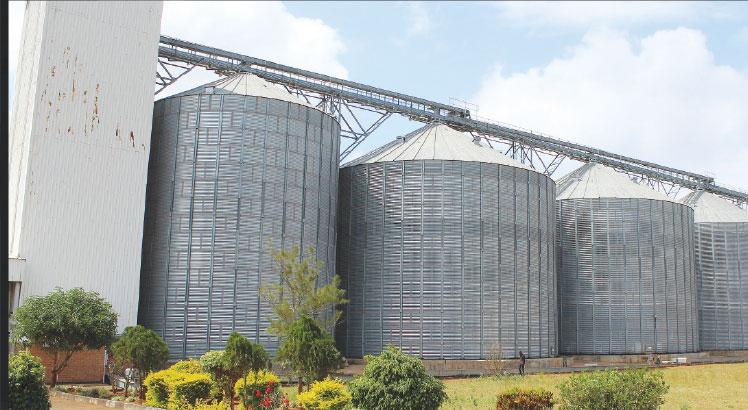K16bn resource Idle for 10 years
Grain storage facilities in Mzuzu and at Luchenza in Thyolo constructed at a total cost of K2 billion in 2010 and 2011 (current cost K16 billion) have remained nonfunctional for over 10 years after they developed faults soon after being commissioned.
The two silos commissioned in 2010 and 2011 were both only used for one year after commissioning due to leakages and high moisture content primarily because of flawed installation of the chain conveyer grain discharge system, according to sources in the agriculture sector.
Between 2007 and 2011, the late former president Bingu wa Muthalika commissioned three modern maize silos in Mangochi in 2007 before those in Luchenza and Mzuzu, to reduce the country’s post-harvest maize losses estimated at between five and 12 percent at farmer level to enhance the country’s food security. Each silo has a capacity of 20 000 metric tonnes (MT).
The silos in Mzuzu were supposed to serve the Northern Region, Mangochi silos were designed to service the Eastern Region while the silos in Luchenza were supposed to cater for the Southern Region.

Besides the three strategic grain reserve (SGR) facilities managed by the National Food Reserve Agency (NFRA), the authority also has multipurpose warehouses at Bangula in Nsanje that holds 3 000MT, a 4 000MT-capacity warehouse at Kazomba in Mzimba, a 40 000MT capacity warehouse in Limbe and at Kanengo in Lilongwe which is the oldest (constructed in 1979) and biggest with a 180 000MT capacity.
In his State of the Nation Address titled, ‘Towards a national consensus on development’, Mutharika delivered during opening of the 2007/08 budget meeting of the National Assembly in Lilongwe on May 21, 2007, he said the silos would attain food security as the country had the capacity to store maize efficiently for two years and avert hunger in future “even if there was prolonged drought and we will also be able to assist other SADC countries in need.”
In an interview on Thursday, Dr Hendrex Kazembe-Phiri, a mechanical engineer from the Ministry of Agriculture who designed the two silos blamed the structural damages on the United Kingdom (UK)-based contractor who was recruited to construct the facilities.
Kazembe-Phiri said after designing the silos he submitted the plan to government which later tendered out internationally and recruited a contractor from England called Bentall Rowlands Silo Storage.
“I designed all the three silos but I was only part of the construction of the Mangochi silos as I left for Japan for my doctoral studies. But I was told, the construction works for Luchenza and Mzuzu silos were rushed up to accelerate project’s completion and that resulted in poor installation of the system,” he claimed.
Kazembe-Phiri said instead of discharging the maize in its original form the chain conveyer grain discharge system which was installed by the UK-based firm was crushing the grain.
“So, when I returned from my studies I did an analysis and recommended that we knock off the faulty initial chain conveyer grain discharge system and install a new system so that the silos resume functioning,” he explained.
All silo structures such as handling equipment, conveyors, weighers, augers and temperature monitoring systems were fabricated in the UK and shipped to Malawi by the UK firm for subsequent erection.
But when contacted through an email this week on the structural damages, the firm’s managing director Gus Walker distanced his company from the mess saying, in as far as his company was concerned, it completed the projects and left everything “in an operational condition.”
Walker explained that while the projects were undertaken before he joined the company, he was aware of the Malawi projects which they did in 2006 and 2008.
He said: “The projects were before my time in the company and I believe we did 3 [three] projects in 2006 and 2008 looking at the files here which are little thin on the ground with information because the company went into liquidation and all records lost.”
However, Walker said some members of staff for his company were still present and “to the best of what they can remember the projects were completed and the commissioning went well, and we left in an operational condition.”
Agricultural and development economist Henry Kankwamba from the Lilongwe University of Agriculture and Natural Resources said while the concept of the metallic silos was brilliant, it has not helped to achieve food security.
“As a matter of fact, we are retrogressing as a country. If you look closely those are assets and depreciation has set in. The silos have lost value for the years they have not been functioning. I will not be surprised, when time comes for restocking, hearing other excuses such as the maize has gone bad because of other aspects,” observed Kankwamba.
But Minister of Agriculture Lobin Lowe in an interview on Monday said, without pointing a finger at anybody, that due to non-functioning of the two silos the country had been operating under a shortfall of 80 000 MT of capacity. Initially, total national storage capacity was 287 000 MT.
However, he expressed satisfaction that the initial storage space would be restored soon as NFRA had finally started maintaining Luchenza and Mzuzu silos following the procurement of a new system from Germany by NFRA.
Said Lowe: “In about a month or so, the Luchenza silos will become fully operational and then we will finalise the maintenance works at Mzuzu silos. Thereafter, NFRA will start restocking the facilities.”
He added: “What is of greatest encouragement is that while the new system has been manufactured in Germany, all the re-installation works at both silos will be carried out by local engineers.”
According to Kazembe-Phiri, the local engineers reinstalling the system are from the Ministry of Agriculture, National Commission for Science and Technology, Malawi University of Science and Technology and Malawi University of Business and Applied Sciences.
NFRA board chairperson Dennis Kalekeni in a separate interview said after the Joyce Banda (2012-2014) and the Peter Mutharika’s governments (2014-2020) failed to bring the silos back to life, the current administration gave his board a target to resuscitate the facilities after over a decade of nonfunctioning.
“It did not make economic sense… It was a waste of government resources to put up such a costly infrastructure and not utilize it. In addition, there are still a lot of workers available as they were not dismissed and are getting salaries for doing nothing,” he said.





